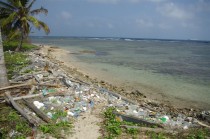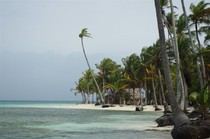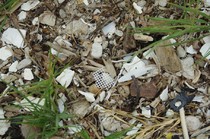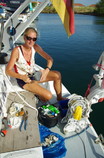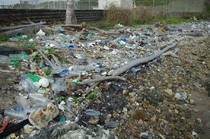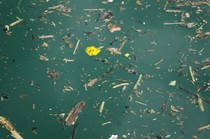Plastic waste in and around Panama
It was not hard to guess that plastic waste would be a huge problem in Panama due its geographic location, both on the Pacific and on the Atlantic side.
On the Atlantic side, Panama Bay is a catch basin for all the flotsam that has been thrown into the water in the Caribbean or flushed into the sea from rivers in neighbouring countries. Since neither Panama nor its neighbouring countries (we limited our own observations to Cartagena, Columbia) have reliable waste collection systems and local people have little environmental awareness, the waste produced locally adds to the problem on the coast. And the situation is no better on the Pacific side. The so-called "equatorial countercurrent" flushes waste from the Eastern Pacific Ocean into Panama Bay. Both coasts of Panama as well as the offshore islands San Blas Islands in the Atlantic Ocean and Las Perlas Islands in the Pacific Ocean are a veritable hotspot of plastic waste concentration. We had a closer look at the following places in and around Panama:
Observations on the San Blas Islands
Logically, waste always piles up on windward coasts. Of course, it is possible to find plastic waste on leeward coasts, too, but this is much less the case.
At first glance, the coasts of the almost uninhabited San Blas Islands did not appear so bad. The small sandy beaches behind the reefs seemed to be clean.
However, when we took a closer look at the exposed roots of the coconut palms and into the loose plant cover which grows on the ground of the palm tree forest, the picture changed. Suddenly, we saw plastic everywhere. Wherever we looked, there was plastic - mixed with a few glass bottles and cans, but their number was insignificant compared to the enormous amount of plastic.
The items we saw most often included water and soft drink bottles made of PET, PE engine oil bottles, lost shoes, probably made from PVC and small pieces of cups and thermal containers from foamed PS. (An incredible number of people in Panama's and Columbia's cities eat and drink from styrofoam containers every day. Warm foods and drinks are usually purchased in thermal containers from small hot food stalls. People take the food they bought in the street and eat it somewhere outside. In large supermarkets, several metres of shelf space are filled with thermal cups and other plastic dishes.) Generally, we found a wide range of products made from plastic on the beaches: from toothbrushes and toys to car bumpers and pram wheels, buckets, plant pots, deodorant rollers, combs and lighters, etc. as well as a myriad of non-identifiable plastic fragments of all sizes. This "plastic confetti", composed of so many different colours and forms, has become an almost imperceptible part of the soil landscape and the palm roots, similar to a large pixel image or a pointillist painting.
It was even harder to perceive the small EPS fractions ("styrofoam" in colloquial language) among the white coral pieces and algae leaves bleached white by the sun. The spot that we studied more closely had a ratio of 90:10, with 90% of white plastic waste and 10% white organic material. And the thermal plastic pieces were not just to be found at the surface. We also found them several centimetres deep in the sand.
We had a terrifying thought: all this stuff, all those tiny pieces will never, ever be removed from the sand. Ever again! It is unthinkable that all these remote beaches will ever be visited by enough people and cleaned thoroughly. You would have to filter several billion tons of sand. Impossible. And if people carry on as before, the waste will pile up, every day, every year, day in and day out...
Who should collect waste here? The one Kuna family that lives here for a few months a year, that harvests the coconuts and cares for the island, sweeping the leeward coast clean every day? Or the few sailors that come here with their dinghies or sea kayaks to stretch their legs a little? Can you actually expect anyone to remove piles of waste that strangers in far-off places have caused many years ago?
We remembered reports by animal rights activists who were concerned about the composition of sandy beaches. Moist sand has excellent heat storage capacities, which allows for turtle eggs to incubate thanks to solar heat, for example. Nature uses a very specific temperature range for this. If the composition of the "sandy" beach changes, because part of the heavy sand is replaced by light plastic particles, its heat storage capacity will inevitably change, too - probably with disastrous consequences for the already decimated turtle population. We do not know what impact a change in sand composition would have on other organisms living in the sand, e.g. all those crabs, but it stands to reason that they, too, would struggle with the changes in their habitat.
Our initial plan of publicising plastic recycling as one way of preventing re-entry of plastics into the oceans seemed a useless solution to the problem at this point. We ourselves doubted whether the plastic we found here would even be suitable for recycling, not to mention the uncertainties about how it should be collected and removed. We decided to test it for ourselves. We took a large garbage bag and filled it on the windward coast of the San Blas island called "Green Island" with all the plastic waste that lay around us. In about fifteen minutes the bag was full to the brim and we had only moved a few metres. Most of that time was spent shaking the sand off the plastic. We returned with the garbage bag by dinghy to the Pagena, where the real work began.
In order to be able to identify what properties plastic waste found on tropical coasts had, we wanted to send a few kilograms back to Germany. To transport the waste and make it storable, we had to wash it and cut it up. Purification was carried out manually using a scrubbing brush in salt water, and shredding was achieved using a pair of multi-purpose scissors, the only available tool. This was a Sisyphean task that gave us blisters on our hands, but which, we hoped, would yield some useful insights. We plan to add to our plastic waste collection in other parts of the world in order to get more kilograms together and obtain a representative cross-section. Then finally, after about ten hours of work and several days of drying out the cleaned pieces, we were left with a plastic waste sample weighing 3 kg, which fitted into two recycled shopping bags.
Since this work entailed every single piece of plastic passing through our hands, we have made a few observations on the ageing behaviour of plastics in the ocean for the technical experts:
- The bodies of the PET bottles and containers collected were all intact. PET does not seem to be embrittled in any way by UV radiation and salt water. Most of the PET containers collected were water and soft drink bottles (which we assume contain no special UV stabilizers).
- Neither were there any signs of embrittlement in the thick-walled containers which, from the whitening on the edges which appeared when cut, we assumed to be made of PVC. Unfortunately, none of containers had a recycling code. Wouldn't it be wonderful if it were compulsory all over the world to identify on packaging what types of materials were used in the making of the plastic...?
- PE containers and products showed varying degrees of embrittlement. Some thick-walled bottles, e.g. motor oil containers and shampoo bottles were either completely intact, or had one hole at most, normally on one corner of the container. Apart from that, these bottles were either only slightly, or not at all brittle. By contrast, we literally crumbled other bottles with the PE recycling symbol (sometimes labelled "AD PE") and screw caps, which to the best of our knowledge are made primarily from PE. PE seems to be able to take on properties which vary greatly in terms of UV and salt-water stability.
- There was sand in some of the (PET, PE and PVC) containers, and some had a green biofilm inside, which was thoroughly cleaned with a brush nevertheless.
- We only found a few plastic sheets made from PE. The few pieces of sheeting that we were able to pick up were full of holes, but still very strong overall. A large piece of sheeting that we could not bring with us, but still took a look at, had a lot of sand washed over it and was therefore pinned to the ground – under the roots of a palm tree. We therefore think that heavy sheeting usually sinks to the bottom, where sand or silt wash over it.
- We mostly found the thin, tough, expanded EPS of thermo cups in torn two-layered folded piece measuring several centimetres in length and breadth. Thick chunks of styrofoam and a yellow foam, which was probably insulation material, were mostly found in large chunks, the smallest being at least the size of the palm of one's hand.
- An alarmingly high number of shoes, parts of shoes and soles were lying on the beach. There were flip-flops, sandals, slippers, trainers or sneakers, and even Crocs, which were on the market only a few years ago. (Shoes, shoe soles and shoe parts were also found in large numbers on the windward coast of Sal [Cape Verde Islands], Bonaire [Netherlands Antilles], and Colon [Panama], and should therefore be considered as globally-occurring plastic waste.) Shoes are made of leather, my foot! Here in the humid tropics leather rots quickly, so lightweight plastic shoes are much better and, moreover, affordable. Therefore, it means nothing if a shoes is lost. In specialist circles there is much talk of "derelict fishing gear" (ghost fishing nets), as there is of consumer packaging. But there is still complete silence on the extent to which the shoe industry is involved in the littering of the coast.
- We have read scientific reports on the analysis of plastic fragments collected at sea, in which we were astonished to note that almost no PET showed up in the samples. Such reports hypothesised that plastic, used extensively in the consumer world, sinks for whatever reason. Such observations are understandable, but we believe the conclusion drawn to be false. PET bottles are found on the coasts in large quantities as intact hollow bodies with a high degree of buoyancy, but never as fragments. The method used for sample collection, therefore, affected the overall result of the analyses.
- Located on the inhabited San Blas Islands, close to the mainland of Panama, it was observed that the Kuna Indians living there keep the island's interior spotlessly clean, but the same is not true for the coastal strip located behind their homes. This is where you will find literal garbage "gardens".
- Returnable glass and cans are collected by the Kuna, but with regards to plastic waste, they obviously do not know where to put it and seem to simply accept it. What worked perfectly well with organic waste for centuries - throwing it into the backyard or the sea and letting it rot - is no longer practical and now requires new thinking and action.
- But how can new thinking and new ways of doing things be introduced into a society which has become so well known precisely because they have to this day maintained their traditions and original ways of life? How – in a society where the wisemen, "Sailas", lie in their hammocks night after night singing old ritual songs, and steer the destiny of their communities by holding a kind of community council called a "congresso"? How – in a society which books say has a largely intact environment, but where in reality (as several independent reports from sailors attest) the waters are hopelessly overfished, and where the individual Kuna flagrantly disregards the Sailas' prohibition of the sale of small and young lobsters between March and May, which he may not be able to catch at all in a few years' time?
Our conclusion from all this is that the problem of "plastic waste in our oceans, coastal waters, and on our coasts" is directly related to consumption, technology and above all to "communal waste management". Herein lies the snag.
Observations in Shelter Bay, Colon, Panama
The small beach in the north of the bay, also a windward coast, looked disastrous. There were huge quantities of exactly the same kinds of items we found in the coastal areas of the San Blas Islands, as described in detail above.
Added to the obvious alluvial waste, other waste had arrived at this remote beach which had obviously not been in the water long. Most striking was that a wide range of tin cans looked as if they had not yet had much contact with salt water.
Shelter Bay is situated on a peninsula, which, although a National Park area, is also home to some commercial operations. From an environmental point of view, the Shelter Bay Marina is no concern, as it responsibly collects and removes waste. However, behind the Shelter Bay Marina, facing the end of the peninsula, there is a production facility for large concrete tetrahedrons which are used as breakwaters. The workers casting the concrete work exclusively in the open and there are no business premises for use as a shelter. Where do they spend their lunch breaks, where do they leave the containers from which they eat and drink? We do not wish to level criticism against anyone, since we realise that these people find it incredibly difficult to dispose of their waste in accordance with our Western European standards.
In Shelter Bay, however, we made another, almost unbelievable, discovery in the nearby jungle. Only ten minutes' walk from the Marina at the end of a roadway into the Latin American jungle, one finds the ruins of "Stanley Battery". The old buildings themselves will be reclaimed by the jungle as a habitat for plants, but on the other side of the road there are lots of blue bottles containing engine oil. It almost looks like an idyllic forest with violets - violets unfortunately they are not... Someone brings all these empty bottles here and throws them in the jungle. Is it the forest workers who need the oil to lubricate their chainsaws? We do not know.
We simply ask at this point how something like this could happen. But if we bear in mind that for the people here, "landfill" is a quite normal method of waste disposal, and it is nothing more than moving the rubbish to somewhere in the jungles where the debris will soon become overgrown with vegetation, we suddenly understand why it is not considered wrong to discard garbage on the spot when it is already in the jungle. From here, at least, it cannot get to the sea and is not on the coast - COPLARE's real area of focus. Seeing this sight did affect us nevertheless.
Observations on Taboga Island in the Pacific Ocean, 7 miles from Panama City
After crossing the Panama Canal, and a few days at anchor in a bay off Panama City, we fled out to Taboga Island to escape from the nastiest oil and waste carpet we had experienced since we started this voyage. We thought the world was still in order in Taboga.
In fact, there was no longer a carpet of oil around Taboga. And the entire contents of garbage bags no longer floated alongside the hull of our ship. Taboga, however, had an eye-opening experience in store for us:
We anchored in the north of the island, right in front of a sand bank, which connects Taboga with the small nearby island of El Morro. Here we felt the full force of the Pacific tidal currents. At high tide the sandbar between El Morro and Taboga is almost completely flooded. Our arrival in Taboga coincided with the peak of the spring tide, i.e. the highest water level of the month. This meant that during the two days we were anchored at Taboga, all the garbage that takes a whole month to accumulate somewhere on the edge of the sandbank or on the beaches, was purged and drifted past our ship.
Besides whole tree trunks and branches of all sizes, there were many countless small pieces of plastic confetti. Brightly coloured, they stood out visually in the sea from the organic rubbish that drifted with the high tide currents past Pagena. In terms of volume, there was much more organic debris than plastic waste, the organic waste being something that occurs naturally is not "garbage" as such. Yet we were terrified by the sight of it all. Because we suddenly saw how difficult it would be for anybody or any single machine to filter out the plastic particles from the enormous soup. In no time at all, filters would get clogged in places like this by pieces of wood and vegetation that exhibit exactly the same buoyancy properties as the floating plastic confetti. Any attempt to filter out plastic waste from the ocean presents a gigantic problem in our view. Only waste disposal methods or methods of use which can "process" both plastic and dead plant matter seem appropriate in the face of this horrific spectacle.
We shall conclude our observations on plastic waste in and around Panama with this thought. Please visit the photo galleries which we publish on this website from time to time. We hope that these observations are given due consideration by specialists in the field who are busy working on concrete technical solutions to mitigate the problem of "plastic waste in our oceans, coastal waters, and on our coasts". Please feel free to contact us via our websites should you have any queries: www.coplare.de or www.coplare.net. We are always happy to engage in constructive dialogue.
Best regards,
Susanne Tölzel and Joachim Probst
COPLARE - Coastal Plastics Recycling e.V.
info@coplare.de

